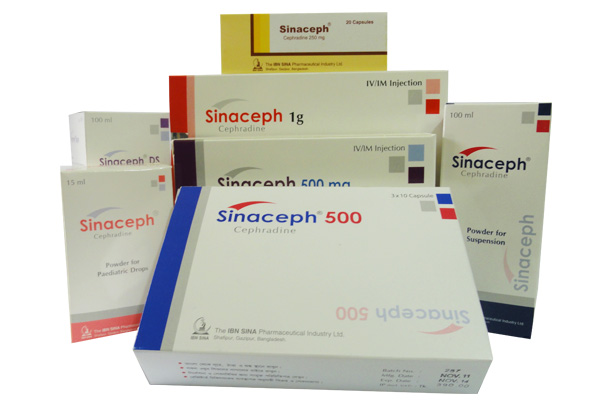
SINACEPH
CEPHRADINE BP
| NAME | STRENGTH | PACK SIZE | DOSAGE FORM |
|---|---|---|---|
| SINACEPH 1 GM INJECTION | 1 GM/ VIAL | 1 S | IV/IM INJECTION |
| SINACEPH 100 ML POS | 125MG/ 5 ML | 100 ML | POS |
| SINACEPH 15 ML P. DROPS | 100 MG/ ML | 15 ML | PAEDIATRIC DROP |
| SINACEPH 250 MG CAPSULE | 250 MG | 20 S | CAPSULE |
| SINACEPH 500 MF CAPSULE | 500 MG | 30 S | CAPSULE |
| SINACEPH 500 MG INGECTION | 500 MG/ VIAL | 1 S | IV/IM INJECTION |
| SINACEPH DS 100 POS | 250 MG/ 5 ML | 100 ML | POS |
Sinaceph 250 Capsule: Each capsule contains Cephradine BP 250 mg. Sinaceph 500 Capsule: Each capsule contains Cephradine BP 500 mg. Sinaceph Suspension: After reconstitution each 5 ml suspension contains Cephradine BP 125 mg. Sinaceph DS Suspension: After reconstitution each 5 ml suspension contains Cephradine BP 250 my. Sinaceph Paediatric drops: After reconstitution each MI suspension contains Cephradine BP 100 rng. Sinaceph 500 Injection: Each vial contains Cephradiric BP 500 mg. Sinaceph 1gm Injection: Each vial contains Cephradiric BP 1 gm.
Sinaceph (Cephradine) is a sernisynthetic: broad spectrum bactericidal antibiotic. It is active against infections caused by both gram-positive and grain negative microorganisms. Both penicillinase-producing and nonproducinq staphylococci are sensitive to Sinaceph. The main site cit action of Sinaceph is the cell wall of bacteria. Cell wall of sensitive organism contains peptidoglycan. Sinaceph inhibits cross-linking process and as a result cell wall with many pores is formed, thus lysis of bacteria occurs due to external osmotic pressure.
Sinaceph is indicated for the following diseases:
Skin and soft tissue infection: Abscess.. cellulitis, furunculosis. impetigo. Urinary tract infection: Cystitis, urethritis, pyelonephritis.
Upper and lower respiratory tract infection: Pharyngitis, sinusitis, otitis media, tonsIlitis, acute and r:hronic bronchitis, lobar and bronchopneumonia. Gastrointestinal infection: Bacillary dysentery, enteritis, peritonitis. Genital infection, Bones and joint infection, Nose, ear and throat infection, Post operative infection and infections caused by sensitive microorganism of Cephradine.
Oral: Adult: For respiratory and soft tissue infections in adults, the usual dose, is 250 oar 500 mg four times daily. For urinary tract infection, the usual dose is 500 mg four tunes daily. For gastrointestinal infection, the usual dose is 500 mg three to four times daily. J:; to 1 gm four times daily may be given for severe or chronic infection, Children: The usual dose is 25-50 mgikglday given in 2 to 4 equally divided doses. For the treatment of otitis media the dose is 75-100 mg./kg daily in 2 to 4 equally divided doses The total daily ucse should not exceed 4 gm.
Parenteral: Adult: The usual dose is 2- :n ia,ly in four equally divided doses up to S gin daily. For prophylaxis, a single preoperative dose of 1-2 gm intramuscularly or intravenously is given. Children: The dose is 50-100 rnglkg
daily in four equally divided doses. up to 300 mg/kg daily in severe infection.
Cephradine is contraindicated to patients who are hypersensitive to Cephalosporin group of antibiotics.
Give cautiously to penicillin sensitive patients as there is evidence of partial cross-atlergenicity between the Cephalosporin and patients with markedly impaired renal function. Cephalosporin is excreted in breast milk and should be given with caution in lactating mothers
Nausea, vomiting, diarrhoea and abdominal discomfort may occur.
Although animal studies have not demonstrated any teratogenicity, safety in pregnancy has not been established. Cephradine is excreted in breast milk and should be used with caution in lactating mothers. Since the medicine may cause dizziness, patients should be cautioned about operating hazardous machinery, including automobiles.
The concomitant use of nephrotoxic drugs such as aminoglycosides with Cefradine may increase the risk of kidney damage. Diuretics (e.g. frusemide, ethacrynic acid) and probenecid enhanced the possibility of renal toxicity.
The symptoms of Sefrad overdose are non-specific and are generally nausea, vomiting, diarrhoea and gastric upsets. Treatment is mainly supportive although gastric lavage will be necessary if a large amount has been ingested.
Cephradine Suspension should be freshly prepared. Reconstituted Suspension should be used within 7 days if kept at room temperature or within 14 days, if kept in a refrigerator. Cephradine Injection solutions should be used within 2 hours when kept at room temperature. When stored at 5°C, solutions retain potency for 12 hours. Reconstituted solutions may vary in colour from light to straw yellow; however, this does not affect the potency. Do not use later than the date of expiry. Keep all medicines out of the reach of children. To be dispensed only on the prescription of a registered physician
Sinaceph 250 Capsule: Each Box contains 20 capsules in blister pack. Sinaceph 500 Capsule: Each Box contains 30 capsules in blister pack. Sinacephl Suspension: Each Bottle contains dry powder for 100 ml suspension. Sinaceph DS Suspension: Each Bottle contains dry powder for 100 ml suspension. Sinaceph Paediatric Drop: Each Bottle contains dry powder for 15 mi suspension. Sinaceph 500 mg Injection: Each Box contains one via; Cephradine BP 500 mg, 5ml water for infection. Sinacepha 1 gm Injection: Each Box contains one vial Coohradine BP 1 grn and 10 ml water for injection.
